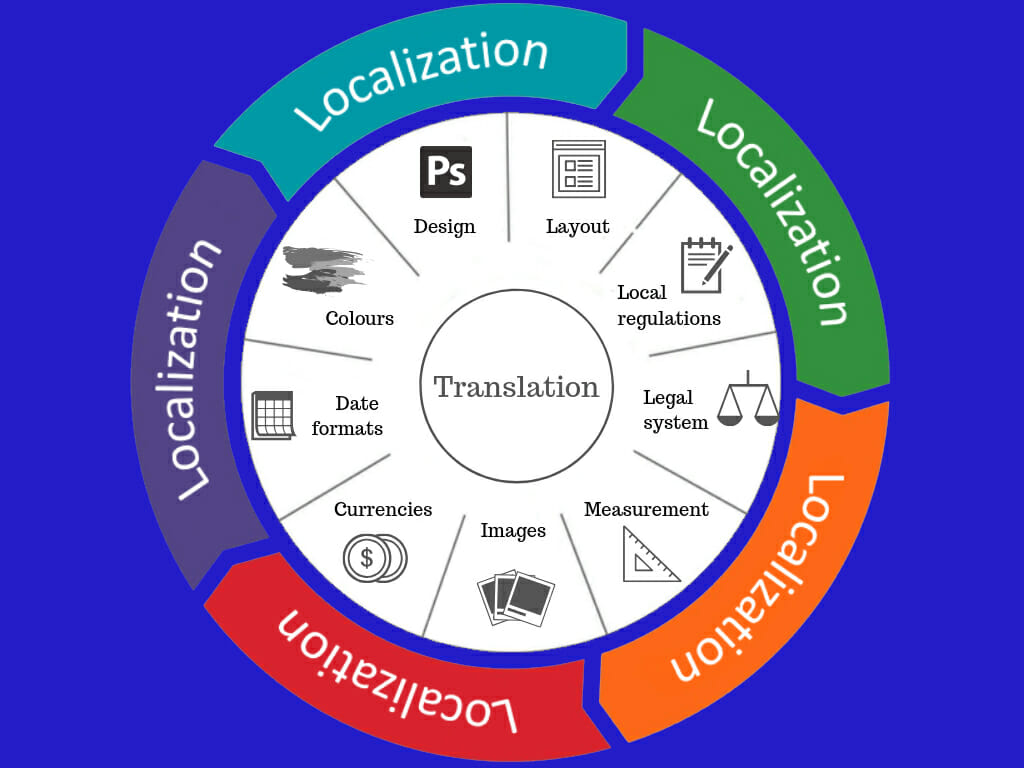Whether furthering the skills and knowledge of your current international employees or expanding your global reach, learning is at the heart of an adaptable business strategy.
Your firm’s presence may already be spread across the world, but ensuring your central ethos goes with it isn’t as straightforward.
Localizing the training material used by pre-existing and new staff is key to giving their learning an agile, tailored edge – an increasingly important priority in our globalized, digital world. This article will lay out the numerous benefits of localizing all aspects of learning resources, as well as some points to consider as you carry out this process yourself. But first things first…
What is localization?
Imagine translating all of your training material into multiple languages: from video subtitles to explanatory case studies, you’ve paid professional translators to convert your content. You upload this new material to its relevant platforms – done! Or not…
The values you wish to convey – your style of doing business, the message you want to send to the world – may remain the same, but in a global market, the recipients certainly don’t. Effective training, which underpins the ability to communicate your culture, runs deeper than language – it’s a process packed with local and cultural references too.
That’s where localization comes in. It goes beyond simple translation and customizes all aspects of your training material. That explanatory case study that worked so well in British English will need an overhaul to remain effective in Chilean Spanish – not to mention the conversion of different units of measurement and date formats.
We’ll go into more detail later, but essentially localization is a process that adapts your company’s presence globally in the most tailored, specific way possible. It takes into account dialectical, local, cultural, and regional differences, ensuring that content is as agile and effective as possible.
Why is localization so crucial to training?
Employee training is the golden link between your business’s core ethos and its deployment in key international markets. Learning gives employees the skills, knowledge and confidence to successfully carry out work in their own specific cultural context. Therefore, the first and most important benefit of localization is:
- Faster, more effective learning
Your source material could seem extremely insightful in its original context, but merely translating it can slow down trainee interpretation and dull understanding. E-training is becoming increasingly widespread thanks to its ease and speed of access, but if an individual is grappling with unfamiliar cultural examples and needing to convert units of measurement, learning speed decreases and frustration is more likely.
Translation allows knowledge acquisition, but localization unlocks knowledge retention, as well as the added plus of employee satisfaction. Knowing they are valued and specifically catered for can make a potentially vulnerable process more enjoyable and relevant. With a clearer focus on the content itself, and not on the hassle of decoding unfamiliar references, training can be completed faster and with more lasting success!
- Increased flexibility
Agile, forward-looking multinational companies are always looking to tailor their strategy to the numerous locales in which they operate. By providing localized training, you gain the ability to do this in the most effective way possible: on the ground, via your employees. Who is better to mediate your message in an international context than the people familiar with that culture?
Since localization also encompasses adaptation to business type, it truly is an invaluable tool when seeking to increase your international flexibility. Offices in different countries and regions will be positioned differently in relation to local government and trade groupings. Ensuring that employees who know these contexts first-hand and are also maximally familiar with the culture and aims you want to put across mean that nothing gets lost in the process.
A further advantage of this flexibility is the empowerment it grants well-trained staff. A positive, culturally sensitive training program can give them the confidence and wherewithal to give feedback that travels up the value chain, improving the business’s relationship to the local community and business infrastructure.
- Legal compliance and employee safety
It might seem obvious, but one of the primary purposes of staff training is to ensure that laws and regulations are followed. This becomes a particularly important priority when a business operates internationally and encompasses numerous legal spheres.
At a base level, other countries may have laws in place relating to staff training itself – it is essential that these are met. Protection of employee health and safety is also of the utmost importance – technical training in these areas leaves no room for ambiguity or misunderstanding. The pharmaceutical and engineering industries are two obvious areas where employees need crystal-clear training to protect themselves and their clients.
Potential issues like data protection and workplace etiquette stretch across virtually all spheres of business, and understanding them relies heavily on intricately localized laws and cultural contexts.
Localizing training not only protects your employees’ and clients’ safety but legally safeguards the durability of your business for years to come.
Some things to consider
The benefits of localizing training material, both necessary and attractive, are numerous. However, the process to attain them, as you might have guessed, isn’t as straightforward as securing a skilled and knowledgeable local translator to do the work for you. Some finer details are worth considering when localizing your multinational business’s training material.
Your base copy
As previously discussed, material that may seem clear and straightforward in its original format is not likely to be directly translatable to a different national or regional context. If you’re building (or writing) from the ground up, ensure your training copy is as neutral as possible – free from cultural references, and with changeable elements like dates and measurements highlighted for conversion. You can almost picture this base copy as ‘contextless’ – in need of contextual ‘translation’ even for those using it in your home or primary locality.
If your company is deploying pre-existing training material into international contexts for the first time, it’s crucial that this content is first neutralized before being translated and localized. The retention of features like storytelling and cultural references can cloud understanding and block retention, but neglect of technical elements like units of measurement and date formats could have dire consequences in the wrong context. Combing your base copy for these kinds of components is crucial for successful and effective localization.
Accessibility
Adapting training content to be accessible to people of all abilities is imperative in meeting disability legislation, ensuring employee safety, and operating an ethical, responsible business. Making sure that all elements of training are localized is part of this responsibility.
Closed captioning, audio, image and graphic descriptions all need translation and localization if accessibility is to be implemented. Features like buttons and menus can also get overlooked, and are essential in creating easily navigable training programs. This is especially important in the context of e-training where employees may not have instant face-to-face access to a supervisor.
Considering all these elements when localizing training could improve your accessibility levels even further – essential to equalizing international understanding of your business’s aims and culture.
Methods of training
The numerous capabilities and features of e-training are important to consider when localizing training material, but other learning methods also require attention. In certain contexts, localization could mean changing how information is delivered – perhaps via an in-person presentation rather than an independently accessed resource.
Again, this presents another opportunity for localization to tailor and focus training material for a specific context – different methods of information delivery will need different considerations.
Consistency
With so many elements and priorities to balance across multiple languages or even dialects, it’s crucial that processes are put in place to ensure consistency. E-training allows content to be adjustable and adaptable like never before, but a rigorous framework like a style guide is crucial in maintaining regularity.
Points, where training software and translation software interact, are key moments of interchange and must be carefully planned and deployed to allow updates and adjustments with relative ease.
Translating and localizing training content into numerous contexts simultaneously is a complex undertaking, but with the right planning and execution, it promises huge payoffs for both your business and your employees’ wellbeing.
Conclusion
Expanding your business’s global horizons harnesses the wondrous possibilities of cross-national and cross-cultural exchange. Don’t let limited translation hinder your efforts – ensure that all aspects of employee training are fully localized, and retain the effectiveness of your training across multiple languages and cultures. Showing your employees that you attend to their specific needs and cultural contexts has a powerful knock-on effect on your business – localize your training material to unlock a world of possibility.





